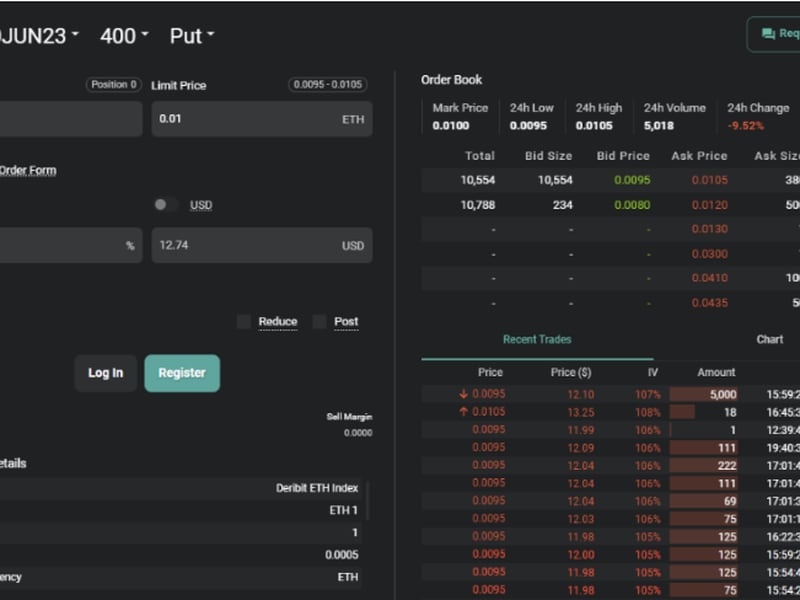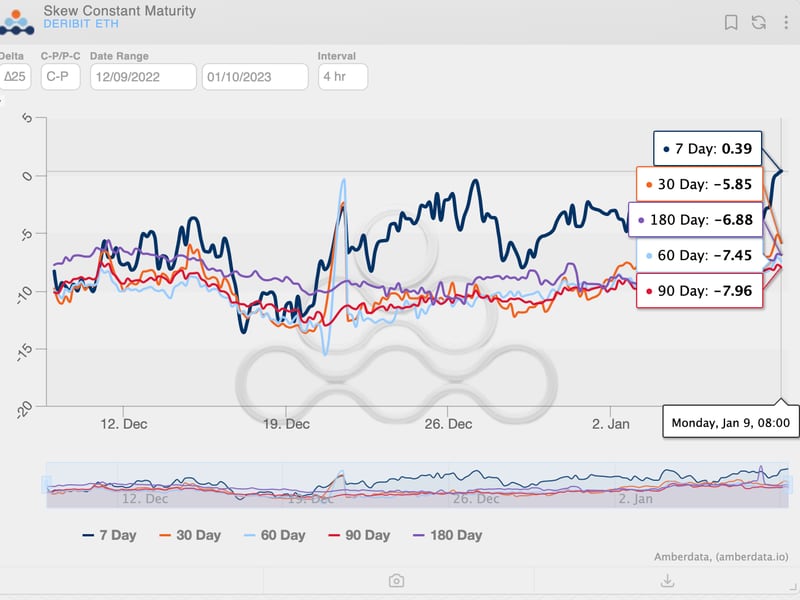The Ether Trade That Made the Most Noise Last Week

During the bull market of early 2021, hyperbullish bets on bitcoin (BTC) and ether (ETH) often crossed the tape on the leading crypto options exchange, Deribit. Two years later the opposite is happening, with market participants betting on an extended slide in ether.
Last week, a buy order for 50,000 contracts of ether's $400-strike price put option expiring in June appeared on Deribit's order book, raising alarm bells in the crypto community. At press time, ether was priced around $1,300, so the put buyer is expecting a 69% slide in less than six months. On Deribit, one ether options contract represents one ETH.
"On ether, the trade that made the most talk was the purchase of puts $400 on June 2023 made on-screen with a resting bid of 50k contracts," digital assets data provider Amberdata said in its weekly newsletter published Sunday.
A put option gives the purchaser the right but not the obligation to sell the underlying asset at a predetermined price on or before a specific date. A put buyer is implicitly bearish on the market. A resting bid is an order whose price is away from the market and is yet to be executed.
"If the entity is willing to buy them, it thinks they have value, which can only be true if it falls below $400," Patrick Chu, director of institutional sales and trading at Paradigm, said.
As of early Monday, the order was partially filled for 40,000 contracts. The purchaser paid a premium of 0.0095 ETH per contract, amounting to a total outlay of 380 ETH or $494,000, according to data from Deribit.

Call and put option buyers pay a premium to sellers as compensation for offering protection against the bullish or bearish move. The premium is the maximum a buyer can lose if the market goes against their position. The profit potential is unlimited because, in theory, the market could see extreme bull runs or drop to zero.
The order might be an outright bearish bet aimed at profiting from a potential price crash. But it might also be a hedge taken against a bullish spot or futures market exposure in ether or other alternative cryptocurrencies. Most cryptocurrencies move in tandem with market leaders, bitcoin and ether.
"It could also be a portfolio hedge," Chu told CoinDesk. "It's common for venture capitalists and other entities with illiquid portfolios to buy downside ETH protection as a correlation hedge."
Griffin Ardern, a volatility trader from crypto asset management firm Blofin called it "tail risk management." Tail risk is the low chance of a move outside the usual range of expected returns.
"Whales typically buy a large amount of out-of-the-money or lower strike options in January/July or June/December as insurance to hedge the tail risk to their portfolio. These options purchases are the whales' last line of defense when the worst happens," Ardern told CoinDesk.
Ether has crashed more than 70% from its $4,868 November 2021 peak, and it remains to be seen if the cryptocurrency slides further, as anticipated by the whale.
The overall options market sentiment remains bearish, with short-term and long-term call-put skews hovering below zero, the chart sourced from Amberdata shows.

The call-put skews measure the cost of bullish calls relative to puts. The negative number indicates a bias for put options.








